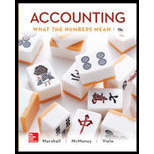
Concept Introduction:
Revenue and Capital Expenditure:
Expenses are categorized in two types for the purpose of recording, Revenue expenses and Capital Expenses. Revenue expenses are day to day operating expenses, whereas the capital expenses are the expenses incurred in acquisition and improvement of assets. The expenses which are incurred in acquisition and improvement of assets are capitalized to the cost of the assets.
Requirement-a:
To Calculate:
The Operating income that should have been reported for the current year
Concept Introduction:
Revenue and Capital Expenditure:
Expenses are categorized in two types for the purpose of recording, Revenue expenses and Capital Expenses. Revenue expenses are day to day operating expenses, whereas the capital expenses are the expenses incurred in acquisition and improvement of assets. The expenses which are incurred in acquisition and improvement of assets are capitalized to the cost of the assets.
Return on Investment (ROI): The return on investment is a profitability ratio that measures the percentage of profit earned on the investment made. It is calculated with the help of following formula:
Requirement-b:
To Calculate:
The ROI using the incorrect and correct net operating income
Concept Introduction:
Revenue and Capital Expenditure:
Expenses are categorized in two types for the purpose of recording, Revenue expenses and Capital Expenses. Revenue expenses are day to day operating expenses, whereas the capital expenses are the expenses incurred in acquisition and improvement of assets. The expenses which are incurred in acquisition and improvement of assets are capitalized to the cost of the assets.
Return on Investment (ROI): The return on investment is a profitability ratio that measures the percentage of profit earned on the investment made. It is calculated with the help of following formula:
Requirement-c:
To Indicate:
The effect of error in future years ROI if not corrected
Trending nowThis is a popular solution!

Chapter 6 Solutions
Accounting: What the Numbers Mean
- Please provide the accurate answer to this general accounting problem using valid techniques.arrow_forwardWipro Plastics uses the weighted-average method in its process costing system. Department A had 4,000 units in beginning work-in-process (60% complete for conversion costs), started 16,000 new units during the period, and transferred 18,000 completed units to Department B. If the ending work-in-process in Department A was 2,000 units (30% complete for conversion costs), what are the equivalent units for conversion costs for the period?arrow_forwardCan you solve this general accounting question with accurate accounting calculations?arrow_forward
- I am looking for the correct answer to this general accounting problem using valid accounting standards.arrow_forwardI need the correct answer to this financial accounting problem using the standard accounting approach.arrow_forwardI need assistance with this financial accounting question using appropriate principles.arrow_forward
- I am searching for the accurate solution to this financial accounting problem with the right approach.arrow_forwardPlease explain the solution to this financial accounting problem with accurate principles.arrow_forwardWhat is the total amount of variable costs related to the units sold?arrow_forward

 AccountingAccountingISBN:9781337272094Author:WARREN, Carl S., Reeve, James M., Duchac, Jonathan E.Publisher:Cengage Learning,
AccountingAccountingISBN:9781337272094Author:WARREN, Carl S., Reeve, James M., Duchac, Jonathan E.Publisher:Cengage Learning, Accounting Information SystemsAccountingISBN:9781337619202Author:Hall, James A.Publisher:Cengage Learning,
Accounting Information SystemsAccountingISBN:9781337619202Author:Hall, James A.Publisher:Cengage Learning, Horngren's Cost Accounting: A Managerial Emphasis...AccountingISBN:9780134475585Author:Srikant M. Datar, Madhav V. RajanPublisher:PEARSON
Horngren's Cost Accounting: A Managerial Emphasis...AccountingISBN:9780134475585Author:Srikant M. Datar, Madhav V. RajanPublisher:PEARSON Intermediate AccountingAccountingISBN:9781259722660Author:J. David Spiceland, Mark W. Nelson, Wayne M ThomasPublisher:McGraw-Hill Education
Intermediate AccountingAccountingISBN:9781259722660Author:J. David Spiceland, Mark W. Nelson, Wayne M ThomasPublisher:McGraw-Hill Education Financial and Managerial AccountingAccountingISBN:9781259726705Author:John J Wild, Ken W. Shaw, Barbara Chiappetta Fundamental Accounting PrinciplesPublisher:McGraw-Hill Education
Financial and Managerial AccountingAccountingISBN:9781259726705Author:John J Wild, Ken W. Shaw, Barbara Chiappetta Fundamental Accounting PrinciplesPublisher:McGraw-Hill Education





